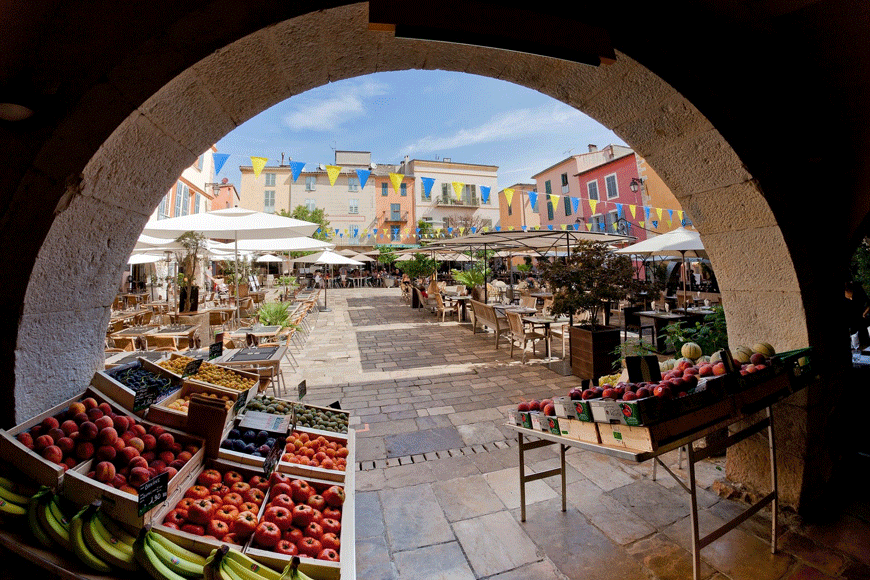France has a reputation for good food, tasty cheese and delicious wine, we’re not teaching you something new there! We can all picture busy café terraces with mouthwatering ‘plat du jour’, a basket of fresh baguette and a bottle of wine on the table. We all stand agape at the window displays of the Patisseries with their elegant cakes and pastries that look (almost) too good to eat! And every town has its weekly market selling seasonal & fresh, local fruit and veg. Each region of France boasts its own dish, but today we are going to focus on south of France food specialties.
What are the food specialties in the south of France?
We’ll begin our culinary journey on the Mediterranean, with the emblematic Bouillabaisse of Marseille. The origin of this traditional dish dates back to the 7th century BC and requires a minimum of four types of fresh rockfish that are then cooked in a redfish broth with onions, potatoes, tomatoes, garlic and herbs, and served with garlic infused croutons or slices of bread.
The Aïoli - delicious mixture of olive oil, garlic and mayonnaise in which vegetables and pieces of fish are dipped. Indeed, olive oil and garlic are often the key ingredients in traditional French cuisine.
Tarte Provencale - a delicious savoury tart with mediterranean vegetables as a filling, including tomato, courgette, onion, aubergine & bell pepper, topped with black olives and goat’s cheese.
South of France food specialties of Provence
The landscape of Provence boasts thousands of olive groves. When you think about it, it takes 8 to 10 kg of olives to make 1 litre of olive oil… and Provence makes a lot of oil! Another delicious way to enjoy this small fruit (yes, technically speaking, the olive is a fruit) is with tapenade. Tapenade consists of a thick paste made of black or green olives, capers, anchovies, olive oil and sometimes garlic and spices. It is served on small slices of bread and is a popular aperitif accompanied by a chilled glass of rosé wine!
Another popular regional dish, a food specialty of the south of France, is ratatouille. Served on its own or as an accompaniment to meat or fish, it is a mix of summer vegetables such as aubergines, tomatoes, courgettes and peppers cooked very slowly with a little olive oil (it’s in almost every dish in Provence!), onions & garlic. A succulent recipe that smells of Provence!
We continue our exploration of south of France food specialties and head now to the Côte d’Azur and discover the French Riviera food in all its glory! We begin with socca, a pancake made of chickpea flour and olive oil, you can eat it plain or with different toppings. The best way to enjoy socca is straight out the oven, be careful not to burn your fingers!
“Petits farcis” are common on menus in the south of France, they are small vegetables such as courgettes, peppers, sweet onions, mushrooms or tomatoes, stuffed with sausage meat or rice.
Pissaladière - a baked tart topped with anchovies, olives and a lot of caramelized onions and fresh herbs. It is also a popular pizza topping.
Anchoiade - a sauce made with olive oil, anchovies and garlic. It can be eaten with bread but is best served with small crunchy sticks of carrots & celery, radishes, cherry tomatoes or artichokes.
You will of course have heard of the Salade Niçoise which is served often as a starter but can also be a meal on its own. Key ingredients include artichoke, hard boiled eggs, tomatoes, anchovies, tuna and olives.
And finally, for something sweet, a south of France food specialty said to be a favorite of Brigitte Bardot: the Tropézienne. This pretty sugar brioche filled with custard and butter cream is a recipe created by a Polish pastry chef in Saint-Tropez, hence the name!
French food of the southwest
Let us now cross the country and head south west to the beautiful and rural region of the Dordogne. Ah, the Dordogne… home to castles, rivers & troglodyte villages, excellent wines and rich cuisine! One of the most famous food specialties of the south of France is, without a doubt, duck. And there is no better region than the Dordogne to taste this delicious meat.
Duck confit - slow-cooked duck legs that are then preserved (“confit’ in French) in fat. When ready to be eaten, they require minimal effort; simply fry them in a little of the fat until the skin is brown and crisp and serve with roasted garlic-seasoned potatoes that have also fried in the same fat. It is rich, it is fatty, it is exquisite!
Foie Gras - duck and goose foie gras are rich and buttery but the goose foie gras is considered the more refined with a milder taste. Available all year, foie gras is particularly appreciated at Christmas time.
Whilst you may have known already that duck and goose are a gastronomic specialty of the Dordogne, you may not know that the same goes for Walnuts and truffles.
Walnut tart - a soft cake made with walnuts from the region. The walnut is strongly linked to the gastronomic heritage of Périgord and has a protected designation of origin (A.O.P).
Dordogne’s Black Truffles - the most fragrant of all truffles can be found in the South of France. It has a complex flavour, with notes of humous, hazelnut and black radish.
What about Corsica, the island of beauty?
The South of France food specialties should also incorporate the culinary delights of Corsica. The Corsicans initially inhabited the mountainous interior of the island to evade the pirates and consequently Corsica was never an island of fishermen although you can now get a lot of fresh fish & seafood.
Corsican charcuterie is world-renowned and remains faithful to the island’s culinary traditions: wild boar stew with myrtle, with chestnut, etc., Corsican lamb & veal with olives, slow roasted with potatoes, rosemary…
Are you hungry yet?




